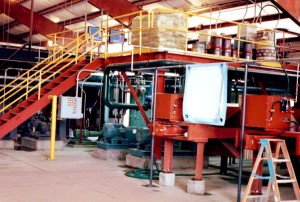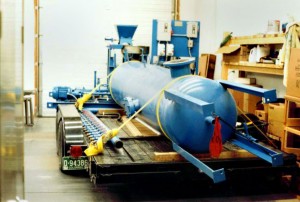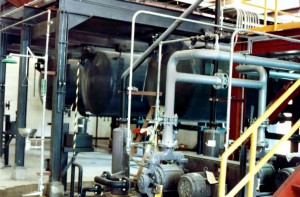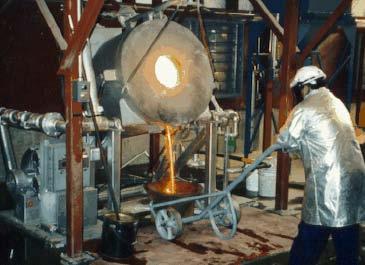CARBON-IN-PULP PIONEERING AT THE CARLTON MILL
HOW CIP PROCESSING BLOSSOMED AS A ROUTINE AT GOLDEN CYCLE IN THE 1950s
John L. Fast, President, Denver Mineral Engineers, Inc.
The affinity of carbon for gold has long been known, and has often caused
premature precipitation problems or losses of precious metals in early cyanide
plants treating graphitic or carbonaceous ores. Many writers have dated the
carbon-in-pulp “renaissance” with the August, 1973, commissioning of the
CIP circuit at Homestake Mining Co.’s plant in Lead, South Dakota (then a
2,200 st/d mill). But the fact is, that the process was used commercially
at least 22 years earlier, demonstrating once again that much that is new
in contemporary mineral processing has been tried before and forgotten, because
the development was either ahead of its time or not useful in the prevailing
economic climate.
Golden Cycle Gold Corp.’s Carlton mill at Cripple Creek, Colo., was the first
major operation to employ carbon-in-pulp recovery for the winning of gold
from ores. Started in 1951 as a 1,000 st/d custom tolling plant that treated
telluride ores of the Cripple Creek/Victor district1.2, the Carlton mill
ran until 1961. The flowsheet employed fluid-bed roasting of the concentrates
and flotation, followed by cyanidation of the calcine and zinc precipitation
of gold. Flotation tailing and concentrate cyanidation tailing were treated
in a carbon-in-pulp cyanidation circuit that was remarkably similar to those
in operation today.
The CIP cyanidation circuit consisted of three 40-ft-dia leach tanks followed
by three 40-ft-dia CIP adsorption vessels. All were equipped with low-speed
agitators and arranged in stepped, one-ft height sequences to provide for
gravitational flow of slurry.
Gold was initially recovered from the carbon by an ammonia-stripping process
developed by the Merrill Co. of Merrill-Crowe fame3. Carbon loaded with gold
was placed in a stripping vessel that was then filled with an aqueous ammonia
solution. The column was then pressurized with ammonia gas, and heat was
applied to the column base.Ammonia vapors exiting the top were condensed
and recycled to the column. Distillation refluxing at 150 lb/in.2 of pressure
continued until the column bottom liquor consisted of a gold-laden water
solution. Gold was recovered from this solution by precipitation with zinc
dust. The column was automatically controlled, and the Golden Cycle staff
had been assured that the unit would operate “similar to a refrigerator.”
Unfortunately, the stripping unit soon became inoperable due to sludge formation
in the “still.” The process was sound metallurgically, but mechanically the
system was too complicated to operate in a mill environment4. The stripping
operation was then converted to the Zadra desorption and electrowinning process
developed by the US BM5.
The Zadra process proved to be easily controllable by the average operator.
Carbon batches of 1,500 to 2,000 lb were contacted with 1% (weight) sodium
hydroxide and 0.1% (weight) sodium cyanide solution at about 193’F for 24
to 36 hr. Solution exiting desorption passed through a Zadra electrowinning
cell and then recycled to stripping. Caustic and cyanide were added to the
recycled solution whenever carbon batches were changed, and the entire batch
of strip solution was discarded every two weeks when steel wool in the
electrowinning cell was changed. Gold-loaded steel wool was smelted in Rockwell
furnaces6.
CARBON REGENERATION
Another major problem developed shortly after the mill start-up. The carbon
rapidly lost much of its activity as it was cycled through the process.
Researchers at both the Merrill Co. and the US Bureau of Mines concluded
that carbon fouling from carry-over of flotation reagents was causing the
deactivation 7,8,9,10. Both groups suggested thermal reactivation of the
carbon, and the Merrill Co. was selected to design and supply a carbon
regenerator.
The kiln installed in 1952 was a 20-in.-dia x 12.6-ft-long, indirectly heated,
rotary calciner. Originally, the kiln was electrically heated and could
regenerate about 500 lb/d of carbon. The electric heaters were soon replaced
with gas burners and the capacity increased to 1,500 lb/d of carbon when
held 10 to 15 min. at temperatures of 1,100 to 1,200’F. This hastily designed
kiln was nearly identical to the regeneration units of today. Procedures
for acid washing of the carbon were also developed by the US Bureau of Mines
during this period”.
The carbon used at the Carlton mill was a 10 x 20 mesh-sized product made
from peach and apricot pits. It was recognized that coconut-shell carbon
would have been more attrition-resistant, but fruit-pit carbon was available
for about half the price of coconut-shell carbon and proved highly satisfactory
for the service. Carbon losses in the circuit averaged about 0.09 lb/st of
ore processed.
CIP TANK SCREENS
Initially, 8-ft-dia x 12-ft-long, rotary trommel screens were used in the
CIP tanks for carbon retention. The ore-carbon slurry flowed out of one tank
and entered the open end of the revolving screen in the next tank. Ore pulp
passed through the screen, which detained the carbon on the screen surface.
As the trommel rotated, carbon was elevated. The water sprays directed such
carbon to a launder for return to the originating tank during normal operation
or diverted it to another launder for countercurrent carbon movement to the
next upstream tank.
The design of the screens had been developed and tested by the Merrill Co.
in a 50 st/d pilot plant that established screen capacity as a function of
pulp density, carbon concentration, and screen mesh.
Operation of the trommel screens was never considered entirely successful.
Mechanical support of the screens was unsatisfactory, partially because a
cantilevered structure was needed to keep one end of the screen open for
slurry feed. Also, at higher carbon concentrations, the carbon would build
up in layers and fall back on the screen, rather than be washed to a launder.
Still another problem with the screens was dilution of the pulp from the
sprays and launder transport water. Typically, slurry would enter CIP at
43% solids and exit at 35% solids (by weight).
To correct such problems, external air lifts were installed to elevate the
carbon-ore slurry to rectangular 3 x 4-ft vibrating screens mounted above
the tanks. Built in company shops, these screens were equipped with two off
balance flywheels to provide a vibratory action. Carbon exiting the screen
surface would normally drop back into the originating tank or be diverted
to the upstream tank if a carbon advance was desired. Ore slurry passing
through the screens flowed by gravity to the next tank.
The installation of the vibrating screens 1-1/2 yr. after the mill start-up
solved the last major problem in the CIP circuit. The Carlton mill continued
to run satisfactorily until it was closed in 1961, a casualty of $35 gold.
However, it was reopened in 1981 as a concentrator based on flotation only.
Recently, it was again converted to a carbon-in-pulp flow-sheet.
In retrospect, the original Carlton CIP was a forerunner of things to come
and perhaps ahead of its time.
John L. Fast is a registered professional engineer and has been involved
in the design of over 20 gold and silver recovery projects. Denver Mineral
Engineers, Inc. specializes in the design and manufacture of precious metals
recovery equipment and systems. The author extends acknowledgements and thanks
to Alan Turner and the library staff of Stearns Roger Division, United Engineers
and Constructors Inc., for allowing access to the company files that provided
documentation for this article.
REFERENCES
1) “Flowsheet-The Carlton Mill,” Mill Tour sponsored by School District
No. 1, Summer, 1959
2) “New Carlton Mill Nears Completion,” Engineering and Mining Journal,
September 1950.
3) Keil H. R., “Notes on Trip to Merrill Co.,” Oct. 18, 1950.
4) Keil H. R., “Letter to G. Norris, West African Gold Corp., Ltd.,”
Sept. 20,1952.
5) Zadra, J. B., Engle, A.L, and Heinen, H. S., “Process for Recovering
Gold and Silver from Activated
Carbon by Leaching and Electrolysis,” US Bureau of Mines, RI 4843,
1952.
6) Keil, H. R., “Carbon Cyanidation at the Carlton Mill,” May
1957.
7) Byler, R. E., “Letter to Max Bowen, Golden Cycle Corp.,” March
21, 1952.
8) Zadra, J. B., “Golden Cycle-Case Study of Ore, Flotation, Cyanidation,
and the Use of Activated Carbon,” Progress Report, US Bureau
of Mines, Jan. 9, 1952.
9) Zadra, J. B., “Golden Cycle of Ore and Carbon,” Progress Report
No. 2, US Bureau of Mines, Jan. 30, 1952.
10) Zadra, J. B., “Golden Cycle of Ore and Carbon,” Progress Report
No. 3, US Bureau of Mines, March 12,1952.
11) Zadra, J. B., “Golden Cycle Carbon Investigation,” Progress Report
No. 4, US Bureau of Mines, Aug. 1, 1952.
JUNE 1988
Fast & Associates, LLC
Denver Mineral Engineers, Inc.
10641 Flatiron Rd.
Littleton, CO 80124 USA
sales@denvermineral.com




 DENVER MINERAL ENGINEERS offers consulting services, designs and a range of mining process equipment for cyanide gold recovery, water treatment and mineral processing. Our equipment has recovered over 50 million ounces of gold at mines around the world. With involvement in over 250 gold and silver mining projects over the past 30 years we can help to advance your mining activities in many ways.
DENVER MINERAL ENGINEERS offers consulting services, designs and a range of mining process equipment for cyanide gold recovery, water treatment and mineral processing. Our equipment has recovered over 50 million ounces of gold at mines around the world. With involvement in over 250 gold and silver mining projects over the past 30 years we can help to advance your mining activities in many ways.